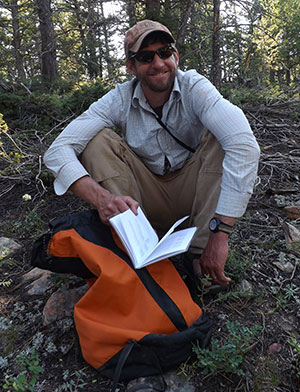
Contact Us
Institutional Communications
Bureau of Mines Building, Room 137
Laramie, WY 82071
Phone: (307) 766-2929
Email: cbaldwin@uwyo.edu
UW Researchers Help Update Plan to Protect Wyoming Bats from Disease
Published December 18, 2020

Ian Abernethy, lead vertebrate zoologist at the Wyoming Natural Diversity Database
at the University of Wyoming, is one of the authors of an updated “A Strategic Plan
for White-nose Syndrome in Wyoming.” (UW Photo)
A plan aimed at protecting Wyoming bats from a potentially deadly fungal disease has been updated, in part, through the efforts of the Wyoming Natural Diversity Database (WYNDD) at the University of Wyoming.
The second version of “A Strategic Plan for White-nose Syndrome in Wyoming” was completed recently by Ian Abernethy, lead vertebrate zoologist at WYNDD, along with Laura Beard and Nichole Bjornlie, of the Wyoming Game and Fish Department, and members of the Wyoming Bat Working Group.
“White-nose syndrome (WNS) has caused the mortality of millions of bats in the United States and Canada since it was first introduced to North America in 2006,” Abernethy says. “Because this disease has the potential to cause large mortality events in bat populations, it is of tremendous management concern for land and wildlife management agencies in Wyoming.”
The fungus that causes WNS was first documented in Wyoming in 2018 at Fort Laramie National Historic Site, although no cases of WNS have been found in the state. The purpose of the revised plan is to help decision-makers in coordinating a statewide response to the disease, and preserve and manage Wyoming’s bats and bat habitat in the presence of the emerging threat posed by WNS.
Eighteen species of bats are found in Wyoming, representing 15 percent of all mammal species in the state. Bats play a key role in many ecosystems, serving as pollinators and seed dispersers for many plant species; and preying on insects that cause significant agricultural losses and threaten human health.
Only one of the Wyoming bat species, the little brown myotis, has been documented to have the fungus; nor has the fungus been found in any Wyoming bat habitat. Still, Abernethy says the fungus and WNS “have the potential to affect many of the bat species that occur in Wyoming.”
That’s because WNS has affected eight of the 18 Wyoming bat species in other parts of their range, and because the fungus has been shown to grow in caves where bats hibernate during winter. Thirteen of Wyoming’s bat species hibernate.
The plan includes recommendations for continued disease surveillance and monitoring; for measures to keep humans, including cavers, from spreading the fungus; for actions to reduce disturbance of bats, particularly during maternity season; and for exploration of options to treat or mitigate WNS.
Work on this version of the plan was funded by the Wyoming Governor’s Big Game License Coalition. It can be found on the Wyoming Game and Fish Department website at https://wgfd.wyo.gov/WGFD/media/content/PDF/Wildlife/Nongame/20201120_WY_WNS_StrategicPlan_FinalDraft.pdf.
Contact Us
Institutional Communications
Bureau of Mines Building, Room 137
Laramie, WY 82071
Phone: (307) 766-2929
Email: cbaldwin@uwyo.edu
